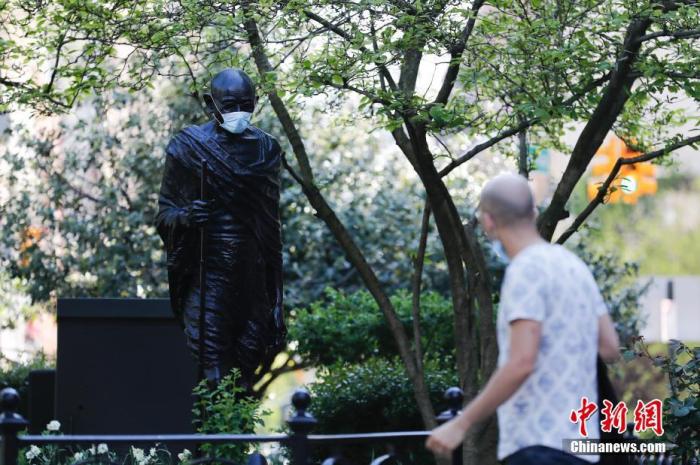China News Service, May 7 (Xinhua) According to an article published by the British Broadcasting Corporation (BBC) on the 7th with the signature of Richard Gray (Richard Gray), under the new crown epidemic, more and more people are wearing masks to prevent epidemic. However, a few months ago, some European and American countries still advised citizens not to wear masks, but to strengthen personal hygiene habits. But as the epidemic spread, the European and American public put on masks, and some governments also changed their original intentions, suggesting that people wear masks in public.
So, how do masks help prevent epidemic disease? Nowadays many countries are gradually "unblocking", do people still need to wear masks?
Data picture: A barista wearing protective masks and gloves is holding a plate full of desserts in a cafe in Rome, the Italian capital. Currently, this cafe only accepts take-out.
way for spreading
To understand the effectiveness of wearing a mask to prevent infection, it is necessary to first understand the method of spreading the new coronavirus.
According to reports, after the human body is infected with the new coronavirus, the virus replicates in the body and exists in the body fluids of the lungs, mouth, and nasal cavity. When the infected person coughs or sneezes, the droplets containing the virus will be ejected. After these droplets leave the body, the larger ones will fall on the surface of the object, and the smaller ones can float in the air.
Other people in the vicinity may be infected if they touch the surface of objects with droplets, and then touch their nose and nose, or they may directly breathe the air with droplets floating, and may also be infected with viruses.
Ben Cowling, an epidemiologist at the University of Hong Kong, said wearing masks can help reduce community infections, especially in public transportation and crowded places.
Gao Benen and his research team recently published a research report on wearing a mask to prevent viral infections. They found that using a general surgical mask can significantly reduce the amount of virus that is ejected when an infected person breathes and coughs.
On May 3 local time, someone put on a mask for the Gandhi sculpture in Union Square in New York, which attracted the attention of many passers-by. China News Agency reporter Liao Panshe
Epidemic prevention loophole
Gao Benen said that after the blockade is lifted, a large number of supporting measures such as sampling and close tracking of contacts must be taken to ensure that the epidemic will not expand again. It is easier for the health department to track the family members and social contacts of the infected person, but it must be tracked Or who is sitting next to you on the train is not so easy.
"At this time, if you wear a mask, or if everyone on the bus wears a mask, you can greatly reduce the infection rate."
Another loophole in epidemic prevention is that before the infection is diagnosed, some people do not have any symptoms, but they already have pathogens and are infectious. In addition, there is a latent period of infection before symptoms appear. And wearing a mask can effectively prevent the occurrence of these epidemic prevention loopholes.
On April 29, the city government of Berlin, Germany began to expand the scope of the city's "mask injunction" from the previous limitation to public transportation to include supermarkets and various retail stores. The picture shows that in the afternoon, customers in the REWE supermarket in the center of Berlin have put on masks. China News Service reporter Peng Dawei
Mask replacement
The big problem now is the insufficient supply of masks. So, can the mask be reused? If general surgical masks and N95 masks are not available, can you use self-made masks with ordinary cloth or use scarves as masks?
Unpublished initial reports of medical research show that masks can be reused after a disinfection process, but this is by no means the best option. Now there are many teachings of self-made masks, generally using cotton fabrics, plus a filter layer of a certain material.
Amy Mueller, an engineer at Northwestern University, examined the effects of homemade masks and found that homemade masks that use multiple layers of fabrics work best, but they are still far worse than N95 masks and surgical masks.
Mueller said that although homemade masks are inferior to surgical masks and N95 masks, they are better than nothing. When people lift the blockade and come back into contact with the outside world, masks can reduce the risk of infection.
In addition, research from University College London in the UK shows that the sidewalk space in London is insufficient to allow people to maintain a safe distance, as is the sidewalk in other major cities in the world. In limited spaces, such as public transportation, maintaining a safe distance is more difficult. If enough people wear masks when going out, it will have a huge impact on the overall epidemic prevention effect of society.
An unpublished study by scientists at Arizona State University shows that even if the effect of masks is average, as long as 80% of people wear them, the mortality rate in New York can be reduced by 17% to 45% within two months. If the mask effect is only 20%, as long as enough people wear it, the mortality rate in New York can be reduced by 2% to 9%.
In countries where there is a shortage of masks, some studies have shown that giving older people priority in wearing masks can also play a very good anti-epidemic effect.

